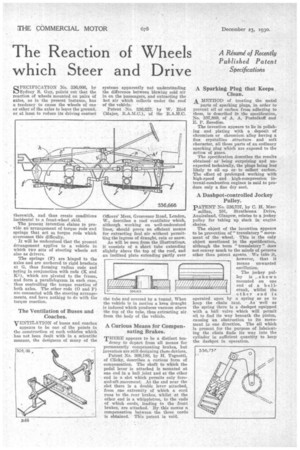The Reaction of Wheels which Steer and Drive
Page 62

If you've noticed an error in this article please click here to report it so we can fix it.
PECIFICATION No. 336,666, by OSydney S. Guy, points out that the reaction of wheels mounted on pairs Of axles, as in the present instance, has a tendency to cause the wheels of one or other of the axles to leave the ground, or at least to reduce its driving contact
therewith, and thus create tonditions incidental to a front-wheel skid.
Tbe present invention claims to provide an -arrangement of torque rods and springs that act as torque rods which overcomes this difficulty.
It will be understood that the present Arrangement applies to a vehicle in which tWo sets of steering wheels act also as drivers.
The springs (F) are hinged to the axles and are anchored to rigid brackets at G, thus forming radius rods and acting in conjunction with rods (K and IV-), which are pivoted to the frame, and form a parallelogram in each case, thus controlling the torque reaction of both axles. The other rods (0 and P) are connected with the steering arrangements, and hare nothing to do with the torque reaction.
The Ventilation of Buses and • Coaches.
VENTILATION of buses and coaches appears to be one of the points in the construction of such vehicles which has not been dealt with in a scientific manner, the designers of many of the Officers' Mess, Grosvenor head, London, W., describes a roof ventilator which, although working on well-understood lines, should prove an efficient means for extracting foul air without permitting the ingress of draught, rain or snow.
As will he seen from the illustrations, it consists of a short tube extending slightly above the top of the roof, and an inclined plate extending partly over the tube and covered by a tunnel. When the vehicle is in motion a keen draught is induced which produces vacuum above the top of the tube, thus extracting air from the body of the vehicle.
A Curious Means for Compensating Brakes.
THERE appears to be a distinct ten dency to depart from all means for permanently compensating brakes, but inventors are still designing these devices.
Patent No. 809,188, by H. Tognotti, of Cliehy, describes a curious form of compensation. The shaft to which the pedal lever is attached is mounted at one end in a ball joint and at the other end in a slot which permits only foreand-aft movement. At the end near the slot there is a double lever attached, from one extremity of which a cord runs to the rear brakes, Whilst at the other end is a whippletree, to the ends of which cords, leading to the front brakes, are attached. 13y this /Malls a compensation between the three cords is obtained. This patent is void. A METHOD of treating the metal
parts of sparking plugs, in order to prevent oil or carbon from adhering to them, is described in the specification, No. 337,889, of A. A. Postnikoff and E. P. Zeredize.
The invention appears to lie in polishing and plating with a deposit of chromium or chromium alloy having a fine crystalline structure and soft character, all those parts of an ordinary sparking plug which are exposed to the action of gases.
The specification describes the results obtained as being surprising and unexpected technically, the plugs being less likely to oil up or; to collect carbon. The effect of prolonged working with high-speed and high-compression internal-combustion engines is said to produce only a fine dry soot.
A Dashpot-controlled Jockey PATENT No. 336,737, by C. H. Mac millan, 101, Strathcona Drive, AnniesIand, Glasgow, relates to a jockey pulley for taking up slack in engine chains.
The object of the invention appears to be prevention of " trauslatory " movement of the wheel. This is the only object mentioned in the specification, although the term " translatory " does not convey much to the minds of persons other than patent agents. We take it,
the spring there is a dashpot equipped with a ball valve which will permit oil to find its way beneath the piston, causing an obstruction to its movement in one direction. The oil which is present for the purpose of lubricating the chain finds its way into the cylinder in sufficient quantity to keep the dashpot in operation.




























































































